Challenges and Opportunities: Digital Learning Transformation at NRS Healthcare
Background of the project
Introduction:
Digital learning transformation can be defined as the process of educating employees of an organisation in terms of improving their skills and abilities in using the automated and digital processes in terms of improving the overall organisational productivity as well as organisational marker growth (Sousa and Rocha, 2019). NRS Healthcare is an award-winning and market-leading organisation in the UK that sells services and products that are designed to support the independent living of people. This organisation is a leading provider of disability aids in terms of improving people's quality of living by promoting their self-dependence. This organisation aims to improve customers’ experiences in terms of promoting their independence thereby improving people’s ability in performing the activities of daily living. Although NRS healthcare is the leading provider in the UK, recently it faces several challenges in the market which not only impacts its customers-base but also its overall market growth. This project of digital learning would assist the marketers of this NRS healthcare to improve its market thereby improving its ability to have a strong competitive position in the international as and as well as domestic market. For those exploring similar topics in their research, healthcare dissertation help can provide valuable insights and support.

The challenges faced by NRS healthcare:
The system and process in terms of delivering learning across the business are non-engaging, non-inclusive and inefficient (Tvenge and Martinsen, 2018). It poses challenges on NRS healthcare to manage risk by conducting compliance training and developing and motivating staff by carrying out the capacity building initiatives. The staff of NRS healthcare are obliged to register and log in to the different external platforms a portal for accessing their learning which leads to waste of time and effort. The compliance learning conducted in this organisation for the staff is a lengthy process and irrelevant which interfere not only with the productivity of organisational staff but also with the organisational growth. Methods involved in the overall productivity and operation are cumbersome and highly complex which make the staff invest more time than necessary (Papke-Shields and Boyer-Wright, 2017.). The existing compliance learning lack of robustness, lack of tools and lack of developmental opportunities which make it difficult for staffs of NSR healthcare to grab high score in the professional development, skill and career development. Most importantly in the overreliance on the manual process is less transparent thereby having high chances of data manipulation and data hacking which interfere with the organisational growth, reputation and trustworthy relationship with customers. In this context, the project of digital learning transformation will provide a highly organised and better learning solution to all the employees which will assist each staff to easily access the online learning and training process thereby supporting their professional and skin development.
Here this assignment will discuss the departmental and organisational strategy of NRS healthcare in terms of achieving the goals of this digital learning project. this study will also discuss the financial activities, resources of this project and it will demonstrate the stakeholder’s analysis and the risk analysis for this project. finally, this study will present a reflective segment in which there will be a reflection on the barriers or challenges that are faced while working on this project.
Organisational and departmental strategy:
SWOT analysis:
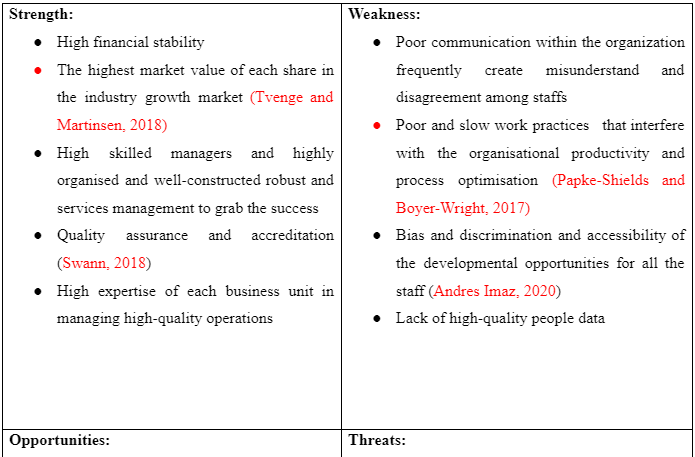

PESTEL analysis:
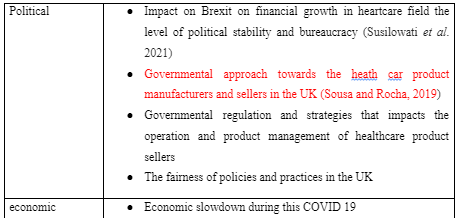


System thinking:
Aim: this system thinking aims to promote better learning that would lead to a better 'bottom-line
Process:
The processes the would be followed under this system thinking of this project are as follows:
Structure:
Improves the interactivity with quality, system, process and framework under this project of digital learning transformation (Fewings and Henjewele, 2019).
Through implementing these innovative technologies into the overall system and operation procedures, it would be possible for NRS healthcare to maintain an effective balance between the speed and ease of using different methods, a high-quality report system and the high standard information value (Fathia et al. 2019).
Internal culture and performance:
The digital learning transformation project will facilitate the NRS healthcare to conduct a better learning program for all staff thereby assisting staff to promote continuous professional development (Demirkesen and Ozorhon, 2017)
The digital learning platform improves the knowledge, skill and professional expertise of staff thereby improving their productivity as well as the overall organisational productivity (Hogarth, 2021).
This digital learning program will improve the communication between all the staff thereby improving the working relationship which will develop a highly supportive, and synergistic work environment (Aragonés-Beltrán et al. 2017).
This digital learning platform will also facilitate a high positive, inclusive and creative work culture which will support the career and skill development of each staff thereby promoting a high level of employee retention and employee management (Wang et al. 2017).
This project is associated with the proactive problem solving and better safeguarding process that will enable this organisation to provide a systematic and highly organised work lifestyle to each staff that will keep staff motivates and engaged in their work (Fathia et al. 2019)
Through this digital learning transformation, NRS healthcare would be able to develop an online training platform in which staff will be allowed to present their diverse and innovative thoughts and creative ideas regarding the market growth and finical growth of this company thereby improving the competitive advantages of this organisation in the market (Khomyakov et al. 2020).
External:
Through conducting this project NRS healthcare can implement the impacts of the improvement on the healthcare services individuals and communities, thereby reducing strains on NHS.
Ripple effects:
This project would enhance the competency of colleagues thereby providing increasing customer satisfaction, reduces customer complaints and develop a strong customer base
Project goals and organisational impacts:
Project aim:
This project aims to provide the employees of NRS healthcare with a technology-based and high robust learning platform that will promote their skill and professional development and improve the financial growth and customer base of this company by promoting its process and service optimisation (Hogarth, 2021).
Project objectives:
To develop, resources and implement a digital learning solution that would assist the business to conduct a bespoke program for capacity building and learning for all the staff (Fewings and Henjewele, 2019)
To assist this business to better engage and retain its people by providing them with the highly supportive inclusive and creative work environment
To conduct effective management handling of big data of both the customers and staff thereby maintaining the privacy and confidentiality of the database (Silvius, 2017).
To leverage innovative technologies into the operation management thereby leading to process and service optimisation which will enhance the overall productivity of NRS healthcare (Antwi, 2020)
To conduct operation excellence thereby producing high-quality products considering the preference and demands of the customers able to meet all needs of customers and improves customer’s experiences (Andres Imaz, 2020).
To support the continuous professional development (CPD) of each staff by proving the staff with new ideas, knowledge and concept regarding the current market trend and customer demand thereby improving the scope for this company to gain a high financial position in the internal and domestic market (Swann, 2018)
To promote revenue growth, cost-effective care, assets utilisation and increase shareholders values thereby promoting the financial growth of this company (Demirkesen and Ozorhon, 2017)
To enhance brain reputation as well as brand value thereby developing a loyal and trustworthy relationship with each customer to maintain long term customer retention strategy.
Impact measurement:
Colleagues: 1300 colleagues
Average salary: £24,000
Based on 1300 colleagues and the average salary this impacts measurement is done:
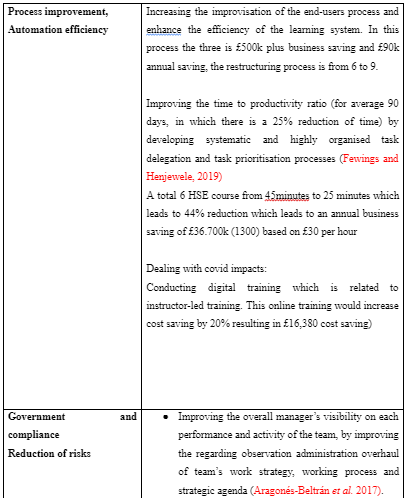
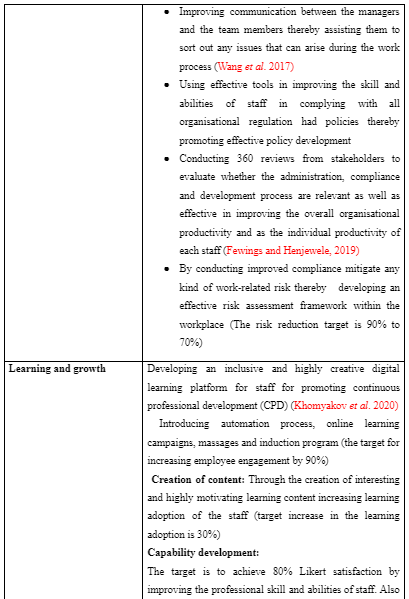

Project goals:
The digital learning transformation project has the following goals
Financially strong performance:
This digital learning transformation project will develop, implement and source an integrated and accessible digital solution that would support all the stakeholders and business units of this NRS healthcare to efficiently deliver their services (Sousa and Rocha, 2019). This way the project will improve the overall productivity of this entire organisation which will support its overall financial growth. By improving the overall operation management, staffs’ skills and professional abilities in dealing with different customers need and fastening the services and product delivery process this digital transformation project will lead to revenue growth of this NRS healthcare by increasing its overall annual sales (Silvius, 2017). This project all support asset utilisation by conducting effective resources management thereby improving productivity. Additionally, this project will also increase the shareholder's value by promoting the finical growth of this company thereby improving the financial standard of this company in the international and domestic market.
Customer experiences:
This project is expected to improve customer experiences by improving the professional ability and expertise of employees of NRS healthcare to analyse the needs, preferences and choices of customers thereby meeting these needs accordingly by providing excellent quality products (Tvenge and Martinsen, 2018). This digital learning transformation project by NRS healthcare is expected to be supportive in improving the knowledge and conceptualisation of the current trend and demand disability products and services in the market that would provide the best experiences to disabled people in terms of leading their life independently (Papke-Shields and Boyer-Wright, 2017). In addition to this, this project is also expected to provide after-selling services to the customers for addressing all their queries and complaints thereby mitigating all these issues by improvising the overall experiences of each customer.
Learning and growth:
This digital learning transformation project is expected to assist the employee of NRS healthcare to develop a creative, productive and supportive work environment in terms of attracting and retaining top talents (Tvenge and Martinsen, 2018).
NRS healthcare developed the strategy of providing an online learning and developmental platform to all the new and existing staff which they can undertake regular training, self-assessment and learning which will improve the professional skill development (Papke-Shields and Boyer-Wright, 2017).
this project is expected to shape the existing professional skill and develop new innovative skin in the new staff who are recruited thereby improving their productivity (Swann, 2018)
This project will provide and support the career pathways of staff thereby directing and guiding employees in undertaking continuous professional development for promoting their career development (Fewings and Henjewele, 2019).
Operational excellence:
This project will assist NRS healthcare to use innovative technology in the operation and production management process thereby leading to process optimisation and dealing as well as capturing big data (Sousa and Rocha, 2019). Process optimisation is business to optimise the production of each operation by introducing supportive and innovative technologies. This project will help NRS healthcare to conduct the service and process optimisation by introducing digitisation and automation to the operation and product management process thereby increasing the overall productivity of this organisation and improve the overall operation.
Project activities:
Financial implications:
Cost benefits analysis:
The estimated overall cost of the project is £52,495 (excluding the internal staff's cost)
Current total spending in the four-training system is £30000 pa
The proposed cost for 1 system is £35,000pa
The cost that is estimated for different aspects of this project is shown in the below-mentioned cost-benefits analysis table:

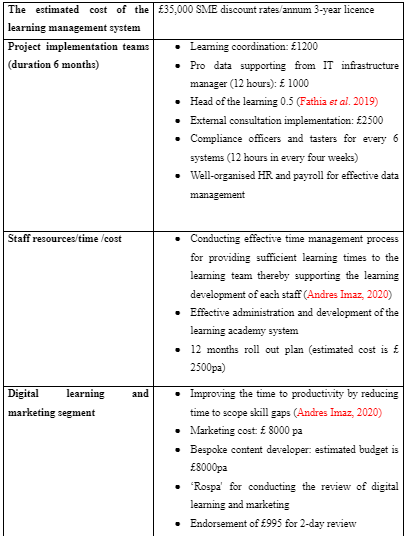
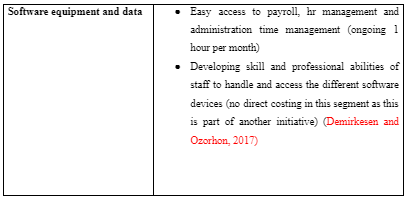
Activities, resources and stakeholder’s analysis:
As defined by Antwi (2020) stakeholders are the agency, persons, business segments or organisations that are directly or indirectly related to the business thereby influencing the overall decision making, activities and operational process of the company.
NRS healthcare have the following stakeholders who influence the business decision, operation process and work process of this company by their activities, decision and performance
Stakeholders’ identification:

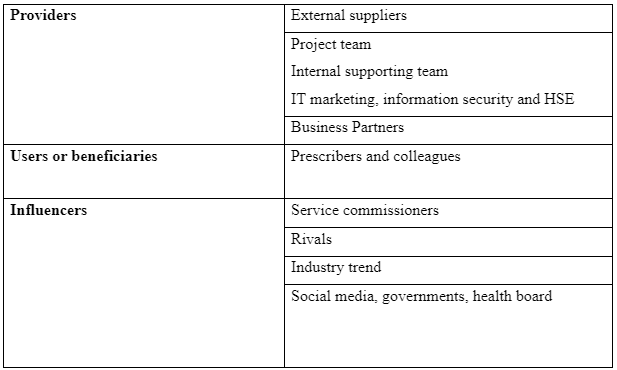
Stakeholder analysis and engagement plan:


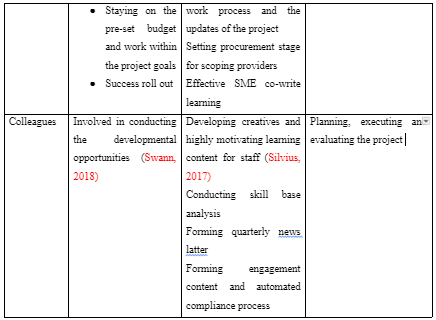
Power interest map of stakeholders:

Explanation:
From the above-mentioned map, the power and importance of each stakeholder can be analysed effectively. As mentioned by Antwi (2020), the stakeholder power analysis is important for any organisational project to assist the organization to understand the values and necessity of each stakeholder. This stakeholder’s power analysis of this project will assist this NRS healthcare to conduct a power analysis of each stakeholder thereby analysing what types of assistance this company can get from each stakeholder and what are the possible strategies that can be used by the project managers to engage and involve the stakeholders according to their designation and powers.
High power and high-interest stakeholders:
Based on this abovementioned power analysis map, it is clear that the stakeholders of NRS healthcare who are highly important for achieving the project goals and meeting the organisational needs are the key players of this project are sponsors, board of directors, project team, SME and governance compliance (Swann, 2018). Key players are the stakeholder who has high power and high interested who must be fully engaged and kept satisfied by involving them in the planning and execution of the project. in this project of NRS healthcare, the project managers must ensure that the key players which are mentioned in this map must be informed of all the necessary details and strategies of this project thereby feeling valued and satisfied (Demirkesen and Ozorhon, 2017).

High power and fewer interest stakeholders:
QA assurance, colleagues, government agencies, health boards and services commission have high power and less interest in the project (Zouid El Bakkali, 2020). All these stakeholders would play crucial roles in all the four stages of the project such as initiation, planning, execution and effective evaluation. By fully engaging all these stakeholders in their project plan the project managers of NRS healthcare care can discuss all the project goals, needs economic, technological and physical resources of this project and the process and services optimisation (Sousa and Rocha, 2019). governmental agencies and health boards could make a positive contribution to this project by taking a supportive and positive approach towards this project such as providing fund support, technical support and raising political and legal assistance (Fathia et al. 2019). On the other hand, the quality assurance team is highly crucial for this project which has the power of administering and analysing the quality of the work process, methods and tools used in accomplishing this project thereby ensuring the quality of this project. services commission will apply their power for overhauling and administering the overall transparency and authenticity of the project work process thereby improving the quality of the project.
Less power and high-interest stakeholders:
Managers, internal support team and early adaptors are such stakeholders of NRS healthcare who have less; power but high interest in this project, therefore, the project managers, must ensure that the necessary and crucial decision of this project must be informed and consulted with these stakeholders (Antwi, 2020). Additionally, as these stakeholders have a high interest in this project, the project managers of NRS healthcare must take necessary advice and guidelines from these stakeholders which it comes to take collaboratives decisions for the project.
Less power and fewer interest stakeholders:
Customers, suppliers, media and partners are the less powerful and less interested stakeholders of this project (Swann, 2018). in this context, project managers will inform these stakeholders regarding the launching of the final products and the benefits and quality of the products and services that are going to launch in the market. although these stakeholders are least important for this project, the project managers of NRS healthcare must ensure that they must deal with these stakeholders in such a manner to maintain a healthy and trustworthy as well as long term relationship with these stakeholders.
Dig deeper into Child and Adolescent Mental Health Services with our selection of articles.
Time management:
Effective time management is crucial for any project which will help the project manager to set time for each aspect of the project (Zafar, 2019). By conducting effective time management project managers can assure that all the project team members will work within the times and the entire project will be accomplished within the expected deadline (Andres Imaz, 2020). Here the project managers have divided the entire task of the project management into different millstones. Then based on these millstones all the project strategies are developed in which the project team will accomplish this project within the times. these millstones of this project is:
Project initiation
Creating a draft of the estimated budget
Creating business impact
Creating a shortlist of suppliers (Andres Imaz, 2020)
Creating department needs report
Creating risk assessment report
Resource requirement
project review
following is the project timeline which will show the times and dates in which different millstones for the project have been set. this project milestone chart will show that how the enter projects are defined and designed by the project manager.

Resources management:
Project managers must ensure that all the resources that are required to design and accomplish the project are available to the project team (Demirkesen and Ozorhon, 2017). For accomplishing this learning project of NRS healthcare project managers has developed a 5M of resource management chart which will show the resources that are needed in this project for its successful accomplishment.

Risk analysis:
Here the project managers of NRS healthcare have developed the following risk assessment framework for overcoming any risk in this project.


Take a deeper dive into Challenges And Dilemmas In Managing Health with our additional resources.
Reflective appraisal:
While working on this project I have faced several limitations or barriers.
One of these challenges is the fund constraints that pose restrictions on the smooth progress of this project, in the aspect I and my team members had to attend several meetings with the sponsors, partners and the board of directors for arranging and maintaining the continuous flow of required fund which can assist this project to be completed smoothly (Fewings and Henjewele, 2019).
Another challenge that I face during working on this project is team conflict and unhealthy competition among team members. there developed an unhealthy competition among the team members of the project team which interferes with the overall success of this project (Demirkesen and Ozorhon, 2017).
Another potential challenge that I experienced during this project is lack of skill and knowledge of some project team members regarding how to set the goals and objectives for a project and to manage the project,
I have addressed these above-mentioned challenges by taking the following strategies:
Through conducting the weekly meeting and official conference with the sponsors, key players and board of directors of this company I have taken an initiative in convincing them to arrange the continuous flow of financial support to this project for successful completion of this project. In this context, I and my team members had to show the expected outcomes and estimated benefits of the project in relation company’s productivity and growth ((Hogarth, 2021).
I have used the effective team management strategy in which I have discussed with all the team members regarding the issues and changes they face in this project and thus motivate them to work n the common organisational goals. Through conducting a training and development program for all the project team members it was possible to improves the knowledge and skill of each team members regarding how a project can be successfully done.
Continue your journey with our comprehensive guide to Digital Learning Transformation at NRS Healthcare.
Reference list:
- Susilowati, M., Kurniawan, Y., Prasetiya, H.P., Beatrix, R., Dewa, W.A. and Ahsan, M., 2021, March. How to manage scope, time and cost of project management plan to develop manufacture information system. In IOP Conference Series: Materials Science and Engineering (Vol. 1098, No. 6, p. 062006). IOP Publishing.
- Papke-Shields, K.E. and Boyer-Wright, K.M., 2017. Strategic planning characteristics applied to project management. International Journal of Project Management, 35(2), pp.169-179.
- Antwi, S., 2020. Project Management Plan for “GH Buy”: A Proposed Online Shopping Platform.
- Andres Imaz, A., 2020. Project management plan definition for the implementation of a European Railway Traffic Management System in Australia (Master's thesis, Universitat Politècnica de Catalunya).
- Swann, M., 2018. Elementary Stem Program project management plan.
- Zouid El Bakkali, S., 2020. Study of the requirements and project management plan of a system to provide relevant environment information for outdoors sports practitioners in urban areas (Master's thesis, Universitat Politècnica de Catalunya).
- Zafar, M.A., 2019. A Study of Project Management Plan of Dasu Hydropower Project Executed by Water and Power Development Authority, Government of Pakistan (Doctoral dissertation, CAPITAL UNIVERSITY).
- Fewings, P. and Henjewele, C., 2019. Construction project management: an integrated approach. Routledge.
- Silvius, G., 2017. Sustainability as a new school of thought in project management. Journal of cleaner production, 166, pp.1479-1493.
- Demirkesen, S. and Ozorhon, B., 2017. Impact of integration management on construction project management performance. International Journal of Project Management, 35(8), pp.1639-1654.
- Fathia, M., Pratam, D. and Hasibuan, M.A., 2019. Designing Mini Master Plan For Developing E-learning Content In Project Management Course (case Study: Project Procurement Knowledge). eProceedings of Engineering, 6(1).
- Hogarth, M., 2021. Project Manager Personal Improvement Plan.
- Madauss, B.J., 2017. Standardized Project Management Plan (PMP). In Projektmanagement (pp. 761-802). Springer Vieweg, Berlin, Heidelberg.
- Aragonés-Beltrán, P., García-Melón, M. and Montesinos-Valera, J., 2017. How to assess stakeholders' influence in project management? A proposal based on the Analytic Network Process. International journal of project management, 35(3), pp.451-462.
- Wang, X., Ren, A. and Liu, X., 2017, August. Researching on quantitative project management plan and implementation method. In AIP Conference Proceedings (Vol. 1864, No. 1, p. 020176). AIP Publishing LLC.
- Khomyakov, I., Mirgalimova, R. and Sillitti, A., 2020, March. An investigation of the project management approaches of agile and plan-based companies. In Proceedings of the 35th Annual ACM Symposium on Applied Computing (pp. 1662-1665).
- 24/7 Customer Support
- 100% Customer Satisfaction
- No Privacy Violation
- Quick Services
- Subject Experts



